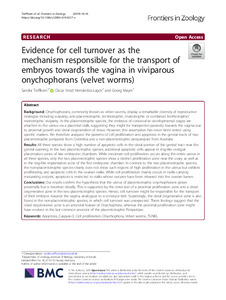| dc.date.accessioned | 2019-09-10T11:17:47Z | |
| dc.date.available | 2019-09-10T11:17:47Z | |
| dc.date.issued | 2019-06-07 | |
| dc.identifier | doi:10.17170/kobra-20190909659 | |
| dc.identifier.uri | http://hdl.handle.net/123456789/11306 | |
| dc.description.sponsorship | Gefördert durch den Publikationsfonds der Universität Kassel | ger |
| dc.language.iso | eng | eng |
| dc.rights | Urheberrechtlich geschützt | |
| dc.rights.uri | https://rightsstatements.org/page/InC/1.0/ | |
| dc.subject | apoptosis | eng |
| dc.subject | caspase-3 | eng |
| dc.subject | cell proliferation | eng |
| dc.subject | onychophora | eng |
| dc.subject | velvet worms | eng |
| dc.subject | TUNEL | eng |
| dc.subject.ddc | 570 | |
| dc.title | Evidence for cell turnover as the mechanism responsible for the transport of embryos towards the vagina in viviparous onychophorans (velvet worms) | eng |
| dc.type | Aufsatz | |
| dcterms.abstract | Background
Onychophorans, commonly known as velvet worms, display a remarkable diversity of reproductive strategies including oviparity, and placentotrophic, lecithotrophic, matrotrophic or combined lecithotrophic/matrotrophic viviparity. In the placentotrophic species, the embryos of consecutive developmental stages are attached to the uterus via a placental stalk, suggesting they might be transported passively towards the vagina due to proximal growth and distal degeneration of tissue. However, this assumption has never been tested using specific markers. We therefore analyzed the patterns of cell proliferation and apoptosis in the genital tracts of two placentotrophic peripatids from Colombia and a non-placentotrophic peripatopsid from Australia.
Results
All three species show a high number of apoptotic cells in the distal portion of the genital tract near the genital opening. In the two placentotrophic species, additional apoptotic cells appear in ring-like vestigial placentation zones of late embryonic chambers. While moderate cell proliferation occurs along the entire uterus in all three species, only the two placentotrophic species show a distinct proliferation zone near the ovary as well as in the ring-like implantation zone of the first embryonic chamber. In contrast to the two placentotrophic species, the non-placentotrophic species clearly does not show such regions of high proliferation in the uterus but exhibits proliferating and apoptotic cells in the ovarian stalks. While cell proliferation mainly occurs in stalks carrying maturating oocytes, apoptosis is restricted to stalks whose oocytes have been released into the ovarian lumen.
Conclusions
Our results confirm the hypothesis that the uterus of placentotrophic onychophorans grows proximally but is resorbed distally. This is supported by the detection of a proximal proliferation zone and a distal degenerative zone in the two placentotrophic species. Hence, cell turnover might be responsible for the transport of their embryos towards the vagina, analogous to a conveyor belt. Surprisingly, the distal degenerative zone is also found in the non-placentotrophic species, in which cell turnover was unexpected. These findings suggest that the distal degenerative zone is an ancestral feature of Onychophora, whereas the proximal proliferation zone might have evolved in the last common ancestor of the placentotrophic Peripatidae. | eng |
| dcterms.accessRights | open access | |
| dcterms.creator | Treffkorn, Sandra | |
| dcterms.creator | Hernández-Lagos, Oscar Yesid | |
| dcterms.creator | Mayer, Georg | |
| dc.relation.doi | doi:10.1186/s12983-019-0317-x | |
| dc.type.version | publishedVersion | |
| dcterms.source.identifier | ISSN 1742-9994 | |
| dcterms.source.journal | Frontiers in Zoology | eng |
| dcterms.source.pageinfo | 16 | |
| dcterms.source.volume | 16 | |

